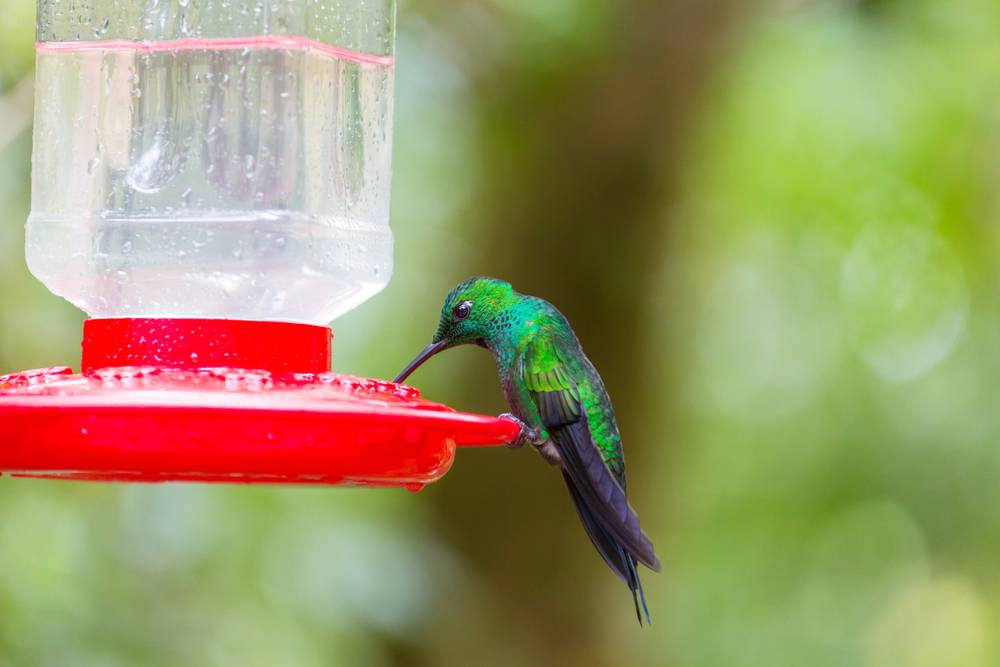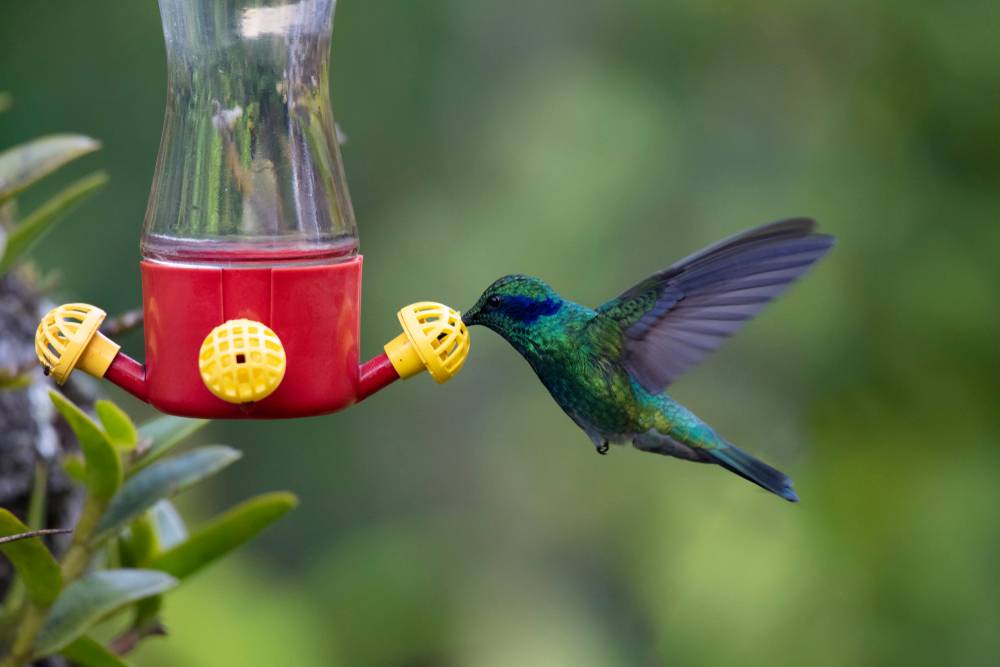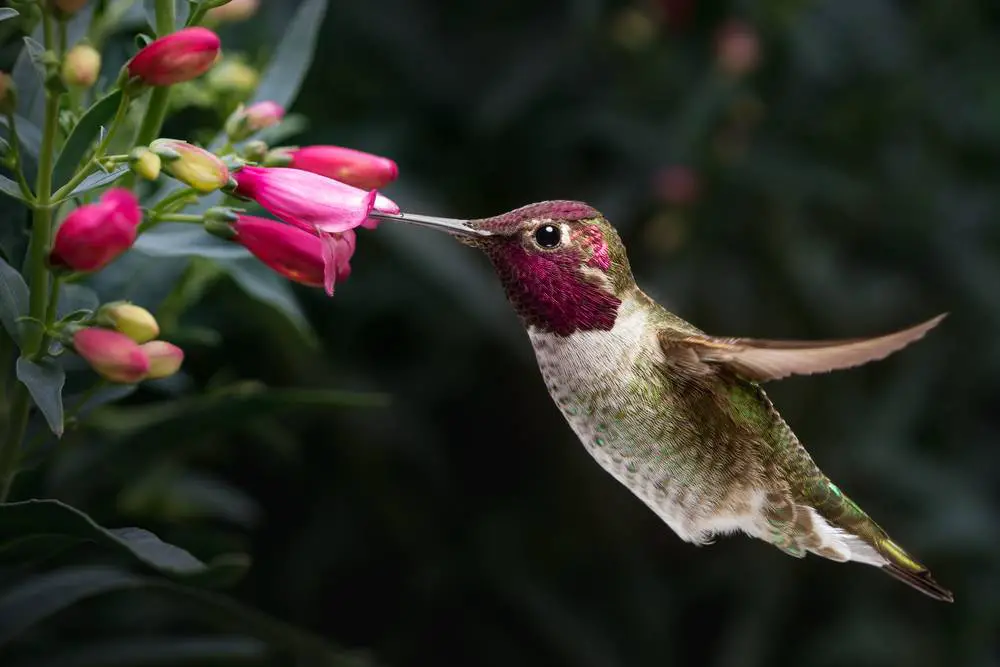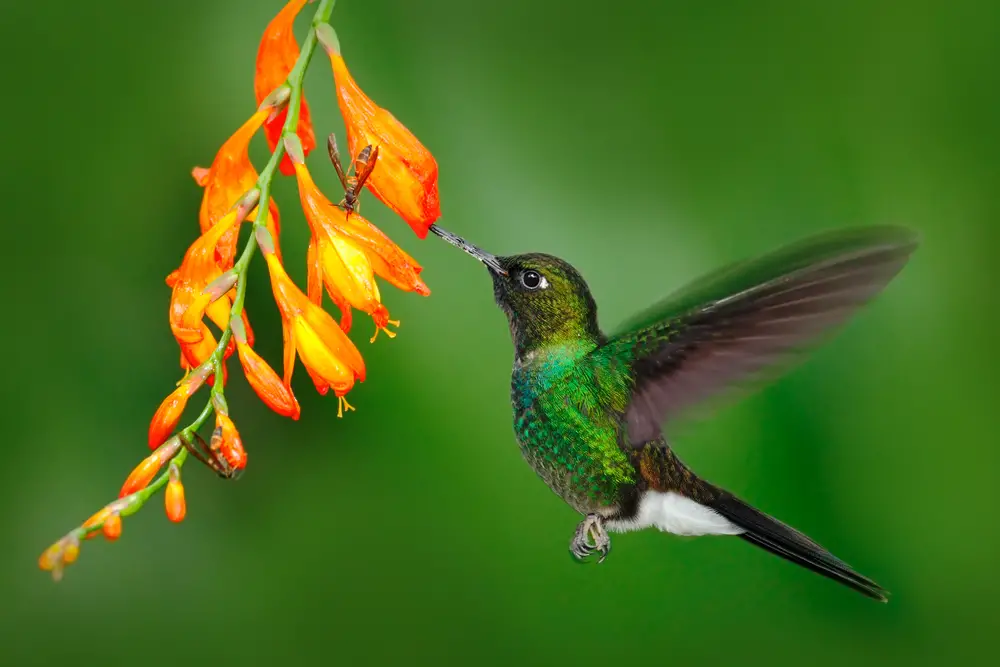People love hummingbirds, and there is little wonder why? These tiny flittering birds are absolutely adorable, and if you set up your hummingbird feeder correctly, you’ll have tons of them in your yard before you know it.
Once you get the right feeder, the next step is finding the right food.
While this step is simple, it is still important that you do it right.
Just as with all other animals, hummingbirds have certain foods they should avoid, so it’s best if you know what those foods are before you get started.
Is Sugar Really Necessary?

While hummingbirds can eat a variety of foods, sugar is the most important food they consume.
Why? Because they need that sugar to give them the energy that’s necessary to flit around and fly from place to place.
And hummingbirds have enormous appetites, often feeding on the sugar about a dozen times per hour.
As a general rule, it’s easy to figure out what type of sugar to use to feed these little hummers.
If you make the nectar yourself, it’s best to use a white cane or granulated (table) sugar.
Hummingbird food has to be healthy, so you should never use any of the following types of sugar to feed your hummingbirds:
- Brown sugar
- Cane sugar that is not white
- Corn syrup
- Honey
- Molasses
- Organic sugar
- Powdered sugar
- Raw sugar
- Turbinado sugar
But just as man does not live by bread alone, hummingbirds do not live by sugar alone.
In fact, you can feed them several types of food simply by placing it on a tree branch near where the hummingbird feeder is, including foods such as fleshy fruits, especially those that are red or pink in color (think grapefruit, watermelons, blood oranges, etc.).
Hummingbirds’ main source of protein comes from insects, but they also eat sap from trees and small amounts of grit.
For your purposes, you can just concentrate on nectar and select types of fruit since they can get those other foods themselves.
Let’s Get Back to the Nectar

The nectar that hummingbirds crave and need can be provided in two ways.
First, you can purchase commercial nectar in nurseries or even food stores. Second, you can make it yourself.
The second way is cheaper, of course, but there are two things that you have to remember:
- If you use tap water, always boil the water and let it cool to remove any impurities
- If you don’t feel like boiling your water, use bottled spring water for the best results
As far as the recipe itself is concerned, it is recommended that you use either a 4:1 or a 3:1 water-to-sugar ratio.
If you use the latter and bees start to become a problem around your hummingbird feeders, you might want to switch to the 4:1 ratio that has a little less sugar in it.
After all, bees love sugar too, but you certainly don’t want them around your hummingbirds.
This is a tried-and-true hummingbird food recipe that has been used by thousands of hummingbird lovers with huge success, and it’s both simple and fast to create.
And if you’ve ever wondered why some people get huge numbers of these adorable tiny birds and you’re seeing very few of them in your own yard, it might have nothing to do with your recipe.
Indeed, it could be other things that you’re not doing quite right.
For example, to enjoy lots and lots of tiny hummers every season, make sure you utilize the following tips:
- Change the food in your feeder twice a week, more often if it’s above 90 degrees Fahrenheit
- Clean the feeder with mild soap and water before filling it with fresh nectar
- NEVER put red food coloring in the feeder because it can be harmful to the birds
- Try to place the feeder in a shady spot and away from other nests whenever possible
- Do not put your hummingbird feeder in the dishwasher; always wash by hand (note: some brands allow you to do this, but check the instructions carefully before putting the feeder in your dishwasher)
And it’s easy to tell if you need to replenish your sugar water supply.
If the hummingbirds stop coming to the feeder or if the mixture starts to look cloudy, it’s time to change the sugar water and put in a fresh batch.
There is really no such thing as putting in fresh sugar water too often. There is only such a thing as not changing the mixture often enough.
The fresher the batch of sugar water, the more likely you will see large numbers of these tiny adorable hummers flitting around in your yard.
As you can see, learning how to make hummingbird food is important, but the care and maintenance of your feeder is equally important.
Tending to these two tasks can greatly increase the number of hummingbirds you find in your yard year after year.
Other Helpful Tips
Just as with most other animals, hummingbirds have natural predators, and one of the ways to avoid your birds being attacked by cats and other animals is to place the feeder a minimum of four feet above the ground.
You can also purchase a “moat” to keep ants and other insects away from the hummers.
Many feeders, in fact, come with their own ant moat, so you won’t have to purchase one yourself.
In addition, if you place the feeder in an area that is visible to you from inside your home, it is much easier to keep an eye on it and therefore discover when there’s trouble nearby.
As far as when you should put out your feeders, that depends on which area of the country you live in.
Below are some general guidelines to follow regarding when you should bring out your hummingbird feeder and hang it on a tree in your yard:
- Southern U.S.: February and March
- Central U.S.: March and April
- Northern U.S.: April and May
- Canada and Alaska: May and June
There are also areas where you can leave your feeders out all year long because of the mild climate.
These areas include the Pacific coast of the U.S., British Columbia in Canada, the Rio Grande Valley area of south Texas and the southern Texas coast, south and central Florida, and southeastern Arizona.
And if you’re wondering whether hummingbirds will remain in the area if you leave your feeders out too long, do not worry.
Hummingbirds have a natural instinct that tells them when to head up north again, and you leaving food out too long doesn’t affect that.
Hummingbirds and Flowers

In addition to feeders and certain fruits, there are other things that can increase the likelihood that hummingbirds will be attracted to your yard.
For instance, planting certain flowers attracts these birds, just as the sugar water and the color red do.
Some of these flowers include foxglove, cardinal flower, red hot poker, trumpet flower, petunias, yarrow, and zinnias, among others.
But you should still have the food ready for the hummingbirds because once the flowers attract the hummers to your yard, they’ll want something to eat!
Some Frequently Asked Questions (FAQs)
Can I change the hummingbird food ratio to something other than 4:1 or 3:1?
You really shouldn’t. If there’s too much sugar in the mixture, it can attract unwanted pests, and if there isn’t enough sugar, the hummingbirds simply won’t be attracted to it. These two ratios really are the best ones to use.
Should I take down my hummingbird feeder when the fall arrives?
Not necessarily. As long as the hummingbirds are visiting your feeder, you can go ahead and keep it up.
When it’s time for them to leave, they’ll leave whether you have your feeder up or not.
Can I make up large amounts of sugar water ahead of time so that I have it when I need it?
Yes. Any unused or unnecessary sugar water can be stored in the refrigerator until you need it for a period of up to two weeks. (Read our blog “Can Hummingbirds Drink Cold Nectar?”)
After that, the mixture should be thrown away and you should make a fresh batch.
Is it true that hummingbirds are attracted to the color red?
Yes, hummingbirds love red! But again, never put any red food coloring in your sugar water because it is unhealthy and dangerous for the birds.
Instead, buy a bright-red hummingbird feeder or place pink or red fruits on the branches near the feeder for better results.
Can I put up more than one hummingbird feeder in my yard?
Absolutely! Not only will you be able to enjoy many more hummingbirds, but territoriality will be much less of a problem.
Just remember to keep all of your feeders clean and filled with fresh sugar water at all times.
Is commercial nectar better than homemade hummingbird nectar?
They are both excellent foods to feed to your hummingbirds as long as you pay attention to the recipe you’re using when you decide to make your own concoction and follow the appropriate ratios.


